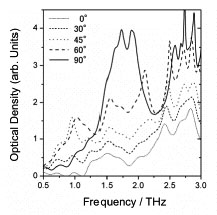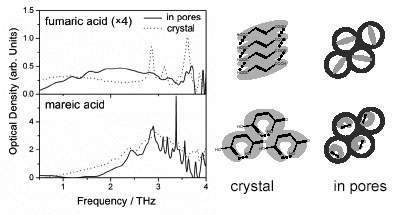Katsuhiro Ajito1, Yuko Ueno1,2,
Rakchanok Rungsawang1, and Isao Tomita1,3
1Materials
Science Laboratory,
2NTT
Microsystem Integration Laboratories, 3NTT Photonics Laboratories
Figure 1 shows angle-dependent THz-TD absorption spectra of cystein single crystal measured by using linearly polarized THz wave. An ab initio frequency calculation of a single amino acid molecule was used to predict the intramolecular vibrational modes. These provide high absorption when molecules are probed with a THz electric field whose polarization is parallel to the oscillating dipole directions [3].
Figure 2 shows THz-TD absorption spectra of two steric isomers, namely fumaric acid and maleic acid molecules in nanosized pores of a mesoporus silicate and their crystals in polyethylene pellets. The intermolecular modes observed with fumaric acid crystals are inactivated by incorporating the molecules in the nano-sized pores due to the separation of the molecules, whereas the intramolecular modes of maleic acid for the crystal and the incorporated samples are similar [4]. Incorporating target molecules in nano-sized spaces is effective in reducing the concentration of the intermolecular hydrogen bonds of the sample, and it is possible to distinguish intramolecular hydrogen-bonding vibrational modes from intermolecular hydrogen-bonding vibrational modes.
We believe that THz spectroscopy will open a new filed in biological analysis in nanospace.
[1] K. Ajito, R. Rungsawang, I. Tomita, and Y. Ueno, Electrochemistry 74 (2006) 506.
[2] Y. Ueno, R. Rungsawang, I. Tomita, and K. Ajito, Anal. Chem. 78 (2006) 5424.
[3] R. Rungsawang, Y. Ueno, I. Tomita, and K. Ajito, J. Phys. Chem. B,
110 (2006) 21259 .
[4] Y. Ueno, R. Rungsawang, I. Tomita, and K. Ajito, Chem. Lett. 35 (2006) 1128.
 |
 |
|||||
|
|